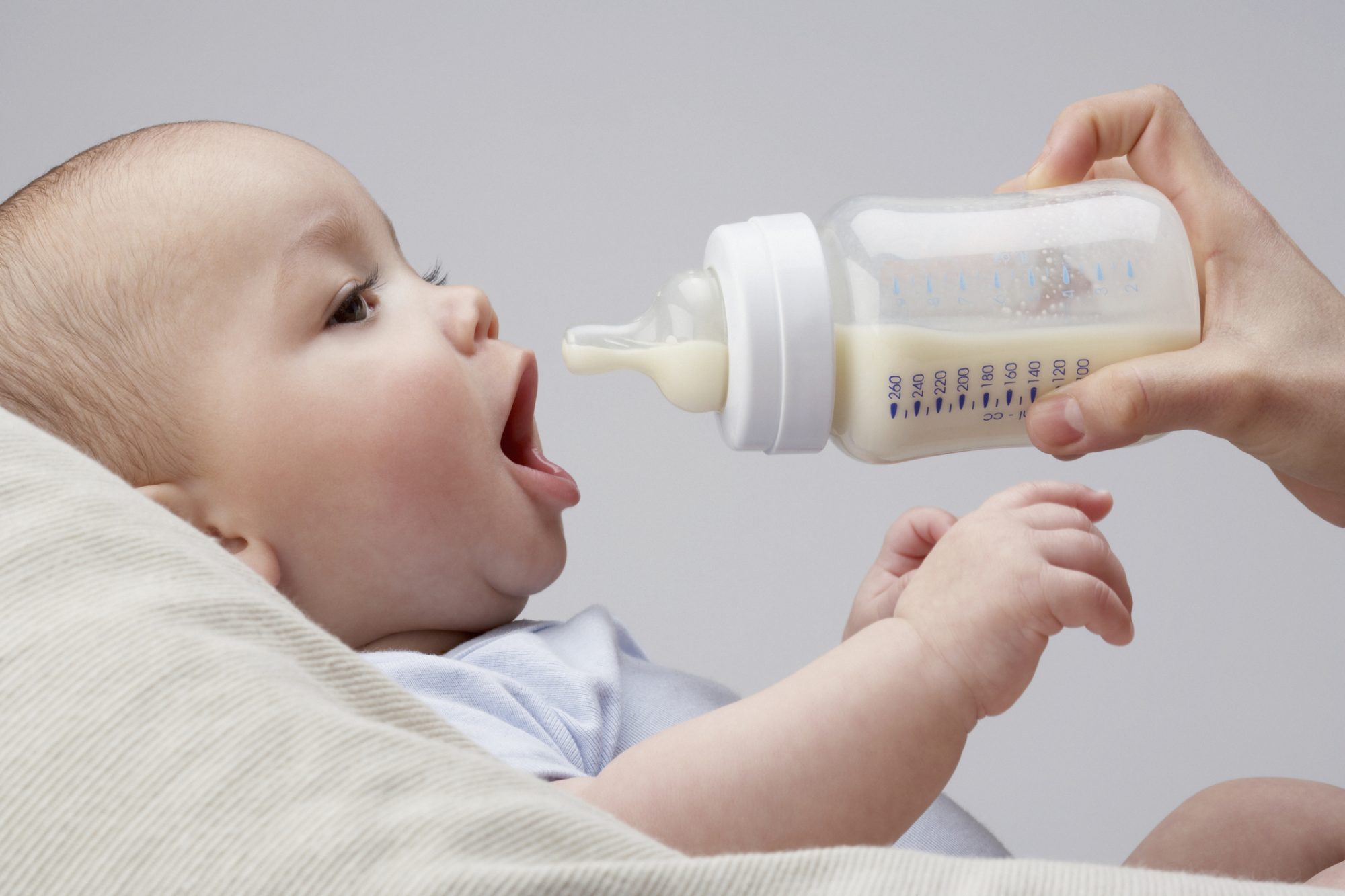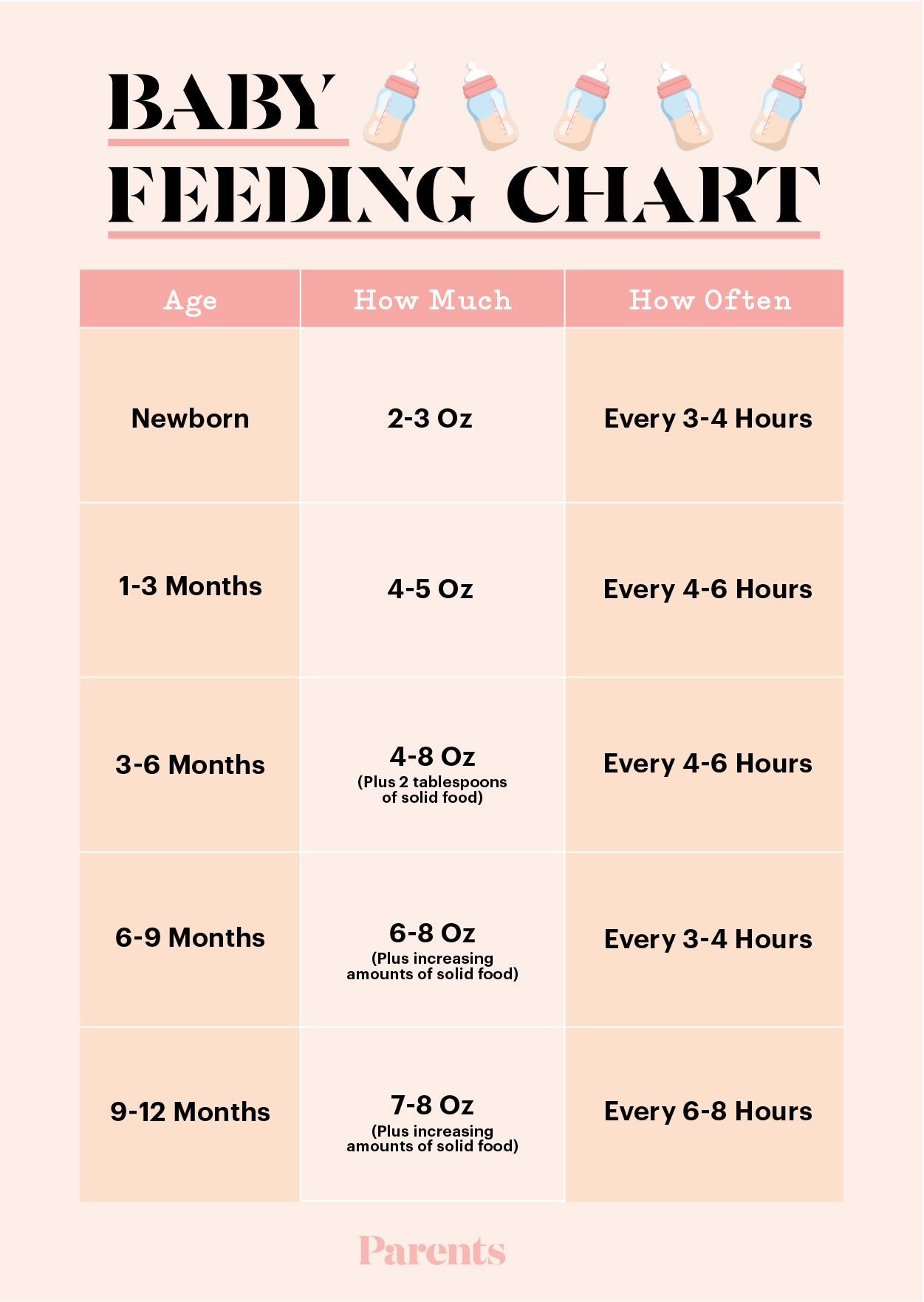
Wondering if you're feeding your baby enough breast milk, formula, or solid food? We broke down some suggested recommendations—but keep in mind that all infants require different amounts depending on body weight, appetite, and age. Ask your pediatrician if you're unsure, then check out our baby feeding guidelines by age.
Newborns
Newborns should receive all calories from breast milk or formula. Here's a tentative breakdown.
Breast Milk: Most newborns eat every two to three hours, according to the American Academy of Pediatrics (AAP), and they drink 1-2 ounces of breast milk per feeding. By the time your baby reaches 2 weeks old, this amount will increase to 2-3 ounces. Generally, you can tell your little one is eating enough if they wet their diaper every three to four hours.
Formula: A formula-fed infant will take about 2 to 3 ounces per feeding, and they’ll eat every three to four hours. This amount will increase as your baby grows. As a rule of thumb, you should aim to feed your baby 2.5 ounces of formula per pound of body weight daily, says Amy Lynn Stockhausen, M.D., an associate professor of general pediatrics and adolescent medicine at the University of Wisconsin School of Medicine and Public Health.
During the first few weeks, if Baby does not wake themselves up in the middle of the night to eat, your pediatrician may recommend waking them for feedings.
1-3 Months Old
Between 1 and 3 months of age, your baby's appetite will increase and they’ll become more vocal about telling you when they’re hungry—especially since they're likely on a regular feeding schedule by this point. The AAP says that a 2-month-old baby will usually eat 4 to 5 ounces every three to four hours.
If you’re feeding formula, look for one that is supplemented with 2’-FL HMO, like Similac Pro-Advance. The prebiotic is naturally found in breast milk and supports gut health.
4-6 Months Old
Most babies are ready to start solids around 5 or 6 months of age. Some indicators that they’re ready: mastering the grabbing skill, developing head and neck control, and losing the tongue-thrust mechanism that automatically pushes food out of their mouth. Never start solids before 4 months.
Aim to feed your little one about 1-2 tablespoons of food twice a day. Solid food shouldn't take the place of milk as the main source of nutrients. Indeed, babies should still drink about 4-6 ounces per feeding when they're 4 months old. Once they turn 6 months old, they may take up to 8 ounces every four or five hours, says the AAP.

6-9 Months Old
When a baby is 6 to 9 months old, nearly all of their calories should still come from breast milk or formula, says Natalie Muth, M.D., R.D.N., coauthor of The Picky Eater Project. Aim to feed Baby no more than 32 ounces of formula daily. When breastfeeding, they should eat anywhere from 4 to 8 ounces at each feeding.
Since Baby is still getting most of their calories from liquid, don’t stress about getting them to eat bite after bite of solid food. Feed up to two meals daily (and as little as one every couple of days), with each meal 2 to 4 tablespoons. Offer foods such as iron-fortified single-grain baby cereal, and pureed vegetables, fruits, meats. (To identify possible allergic reactions or digestive issues, don’t introduce more than one food at a time.)
Around this time, you should also start offering finger foods like strained vegetables, fruit, yogurt, cottage cheese, and casseroles. "One of the things I really like about casseroles is that if the child likes the base flavor, you can add a bunch of other vegetables to it, and he's often fine with it," says Alan Greene, M.D., author of Feeding Baby Green, who makes a pasta casserole in red sauce for his family.
If they seem to have an insatiable appetite or don’t seem to be eating enough, contact your pediatrician.
9-12 Months Old
At this age, babies should have about 7 to 8 ounces of liquid per feeding. They usually cap out at 32 ounces of formula in a 24-hour period. “By 9 to 12 months, about half of your baby’s calories should come from food and the other half from breast milk or formula,” Dr. Muth says.
Growing infants tend to have an adventurous palate—they’ve learned eating tastes good, so don’t be afraid to give them chopped-up nibbles from your plate. If they want more, feed them more, but if they push food away, don’t take it personally.
Babies like to play with their food, so also consider using yogurt or oatmeal as a dip for vegetables or whole-grain crackers. Just remember to chop or dice foods and to avoid those that are small, round, hard, or the size of a child's airway.
After 12 Months
“After the first birthday, most of the calories your baby consumes should come from finely chopped table food,” Dr. Muth says. To meet their calcium needs, serve whole milk in a sippy cup at meals and with snacks. Toddlers should drink about 2 to 3 cups a day. Aiming for set meal and snack times can also pay off, since they’ll be more hungry and thus willing to try new things. Remember to always consult your pediatrician if you're unsure about baby feeding guidelines.





